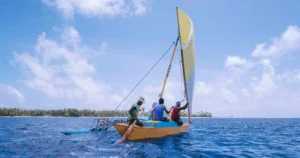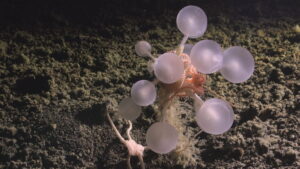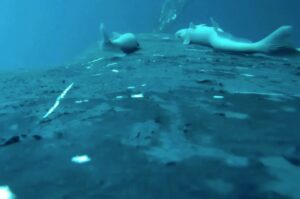When embattled deep-sea tourism startup OceanGate lost its only submersible and its CEO in one catastrophic dive last June, reactions varied.
Most of the world watched with bated breath as emergency crews tried to locate the lost ship and rescue its five-person crew. Media focus ranged from tragic and personal to skeptical — repeated safety issues and setbacks had plagued the Titan throughout its development. Stockton Rush, OceanGate’s CEO and the submersible’s pilot, had made charged comments about regulations and safety in the deep-sea exploration industry.
To state it gently, the Titan was an outlier in design. The pilot’s interface was a video game controller. The only interior fixtures were two screens and a front porthole window. And the crew squatted on the floor for the duration of each voyage, seated on a plain rubber mat.
Not to mention its carbon fiber hull — a first-of-its-kind gambit that, now, will likely never again be attempted.
The search for the Titan and its crew ended when remotely operated vehicles found it in pieces on the ocean floor. The U.S. Coast Guard called the incident a “catastrophic loss” of pressure inside the cabin. Official investigations commenced, and OceanGate promptly shuttered operations.
James Cameron speaks out
Some experts, including experienced deep-sea submersible pilot and film director James Cameron, later implied Rush had been on a dangerous crash course all along.
“You don’t move fast and break things if the thing you’re going to break has got you inside it,” the director recently told 60 Minutes Australia.
As the Coast Guard and other agencies continue their investigations, tech news outlet Wired recently shared the results of its own year-long probe involving “tens of thousands” of OceanGate documents and internal communications.
Dating back to the company’s early days in 2013, the investigation plots a chronicle of compounding decisions by Rush and other key individuals leading up to the Titan disaster.
This timeline navigates the tortuous development of the doomed submersible.
2009
OceanGate opens with plans to charter deep-sea trips for tourism and research. It first uses older, steel-hulled craft.
2013
CEO Stockton Rush announces plans for a new carbon-fiber submersible. The lightweight material makes a cylindrical build feasible, according to Rush, adding more capacity for passengers than traditional sphere-shaped designs.
2015
OceanGate first tests the concept with a steel prototype called the Cyclops 1. Red flags pop up right away. Reporting for New Scientist, investigative reporter Mark Harris dives with Rush in an early test. He reports the Cyclops glitches badly at only 130 meters.
‘Scared the shit out of everyone’
2016
Designs continue to fluctuate and fail across multiple experiments with different materials for critical components. Wired later reveals OceanGate’s testing protocols clash with engineers’ recommendations.
According to Wired:
- In a pressure test at a University of Washington lab, a carbon-fiber scale model of the Cyclops 2 implodes at about 6,500 psi — close to the water pressure at 3,800 meters, the depth of the Titanic, but thousands of meters short of OceanGate’s target safety margin. “The building rocked, my ears rang for a long time,” reads an employee email. “Scared the shit out of everyone.”
- Cyclops 2 prototypes never survive the targeted safety-margin pressure in testing, and the company never tests the titanium components the final sub will use in conjunction with the fiber. Instead, the company thickens the hull specs from 4.5 to 5 inches and commissions a contractor to build the final design.
- When it arrives, it is too thick for portable ultrasonic testing equipment. Ultrasonic testing can detect miniscule flaws or weak points in the final product without destroying it. Testing would have been possible with a stationary ultrasonic rig. Instead, Rush concludes transporting and testing the Titan is too expensive. Ultrasonic tests never occur.
- Finally, the ship uses an acrylic viewport that falls far short of pressure safety targets. Will Kohnen, the designer of the nine-inch-thick unit, later tells Wired that OceanGate fell well short of a rigorous testing protocol for the unit. He claims that he only rated the window to 650 meters. When he urges Rush to reconsider the component, the CEO allegedly refuses.
‘You are going to kill someone’
2018
According to Wired:
- Rush fires marine operations manager David Lochridge after Lochridge refuses to sign off on the final sub, citing 27 safety issues from flammable materials to missing bolts and more concerns over the carbon fiber hull. Lochridge files a whistleblower report to the Occupational Safety and Health Administration (OSHA), but Rush sues him for breach of contract, leading Lochridge to drop the complaint.
- “Titan and its safety systems are way beyond anything currently in use…I have grown tired of industry players who try to use a safety argument to stop innovation and new entrants from entering their small existing market,” Rush wrote to McCallum in one of the Wired documents. “Since [starting] OceanGate, we have heard the baseless cries of ‘You are going to kill someone’ way too often.”
- Rob McCallum, a deep-sea explorer, also seeks to discourage Rush from proceeding in a petition drafted by Kohnen.
- One safety system relies on acoustic feedback from the carbon fiber hull as it crackles and pops under pressure. OceanGate frames it as an early-warning system that can signal the crew to surface at a certain threshold of “micro-buckling.” A safety consultant familiar with material acoustics says that the noises actually indicate “irreversible” damage to the hull.
- Real-world testing began but proceeded poorly. The submersible once nearly broke apart in shallow, choppy water with Rush inside. And when the Titan first reached 4,000 meters, the hull warped alarmingly — by up to 37% more than intended, according to engineers.
- Rush starts to worry about noises from the hull at depth. Finally, a pilot inspecting it with a flashlight notices a crack. Later, OceanGate finds 11 square feet of carbon fiber delaminated — meaning the layers of material had separated.
A successful dive
2021
According to Wired:
- Contractors re-manufacture the carbon hull using updated techniques. It passes pressure tests at a University of Maryland lab, but OceanGate elects to salvage the old titanium rings from the damaged sub based on Rush’s intolerance toward added cost and delay.
- An employee spots new lifting points attached to the two titanium rings. They’re a new addition, and a representative from the original manufacturer had warned OceanGate back in 2017 to raise and lower the vehicle only with nylon slings: “The titanium cannot take load/tension,” the individual said.
- July 13 – OceanGate completes its first successful visit to the Titanic with tourists.
2022-23
But problems persist, from inane to frightening. OceanGate cancels a 2022 mission with Intelligencer reporter David Pogue on board when, 11 meters below the surface, two rubber floats come partly untethered from the sub’s launching platform.
View this post on Instagram
‘MacGyvered’
The event comes a year after a crew gets trapped on board the Titan. Instead of the programmed six hours, the expedition lasts 27, much closer to the cabin’s 96-hour oxygen threshold.
Inspecting the vehicle before his failed outing, Pogue tells Rush that the sub feels “MacGyvered.” When Rush acknowledges the comment, Pogue asks if that has concerned anyone else in the deep-sea industry.
Rush tells Pogue:
Oh yeah! Oh yeah. Yeah, no, I’m definitely an outlier. There’s been more intrigue into that than I can go into. There were a lot of rules out there that didn’t make engineering sense to me. They made sense at the time, in the ’60s and ’70s. But, you know, there’s a limit. You know, at some point, safety just is pure waste. I mean, if you just want to be safe, don’t get out of bed, don’t get in your car, don’t do anything. At some point, you’re gonna take some risk, and it really is a risk-reward question. I said, “I think I can do this just as safely by breaking the rules.”
June 18, 2023 – Titan dives toward its famous target but never returns. The U.S. Navy eventually reveals it detected “an acoustic anomaly consistent with an implosion” shortly after the Titan’s surface crew lost contact with it, according to CBS.
The U.S. Coast Guard launches an investigation, which continues today.






